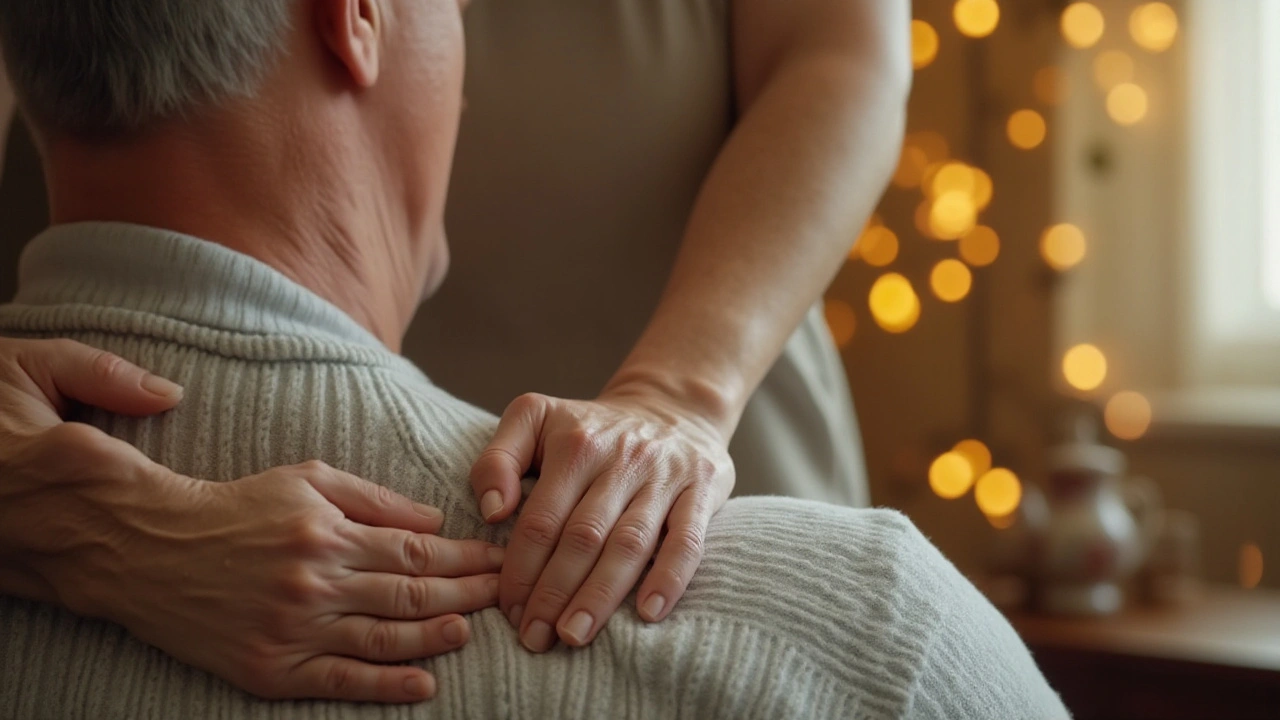Palliative Massage for Enhanced Patient Wellness

Palliative massage offers a gentle and profound way to support those grappling with serious illnesses, bridging the gap between physical care and emotional solace. This specialized form of massage therapy plays a crucial role in alleviating pain and discomfort, aimed at enhancing the overall well-being of patients when they need it most. It's not just about the physical touch - it's about enveloping patients in a comforting presence that promotes peace and relaxation.
As patients navigate the often tumultuous journey of chronic illness, palliative massage provides an oasis - a place where holistic healing starts anew. This practice is more than meets the eye, addressing not just physical symptoms but emotional and mental stresses too. By adapting techniques to each individual's unique needs, palliative massage offers a personalized approach that honors the patient's story and their present needs.
- Understanding Palliative Massage
- Benefits on Physical Health
- Emotional and Mental Health Support
- Personalizing Massage in Palliative Care
Understanding Palliative Massage
Delving into the realm of palliative care, palliative massage emerges as a profound modality that offers relief beyond conventional treatments. Rooted deeply in the idea of providing comfort and support, palliative massage zeroes in on alleviating symptoms associated with serious illnesses. Unlike more traditional massage therapies that might focus on muscular knots or generally aim to invigorate, palliative massage is uniquely soothing, concentrating on gentle, nurturing techniques. It's an approach tailored to accommodate each individual's condition, promoting tranquility over intensity and recognizing the delicate nature of the patient’s physical state.
In many ways, palliative massage serves as an embrace when words or medications fall short. The overarching goal here isn't just about physical relief but about fostering an environment where a patient feels valued and understood. This form of massage aids in reducing symptoms like pain, anxiety, and fatigue, harmonizing with the body’s natural rhythms. It's a therapy that acknowledges how chronic illness impacts not just the body, but the mind and spirit, too. Significantly, it can boost mood, lower stress levels, and improve sleep quality—particularly important facets for someone dealing with continuous health challenges.
Amidst the therapeutic landscape, palliative massage occupies a special niche, offering a gentle anchor through storms of uncertainty. Many practitioners highlight the importance of customization in each session, as the needs of someone undergoing chemotherapy versus someone wrestling with neurological issues can vastly differ. Thus, the method is tailored to honor the distinct, evolving needs of the individual. This adaptability helps ensure that each massage is not only physically soothing but emotionally reaffirming.
According to the American Massage Therapy Association (AMTA), "massage therapy can significantly enhance a patient's quality of life by promoting relaxation and comfort during stressful times." The practice encourages a greater connection between the therapist and the patient, where a simple touch communicates care, compassion, and a shared journey toward comfort and healing. Touch remains a powerful tool; its effects on well-being shouldn't be underestimated.
Palliative massage stands at the intersection of science and empathy in care provision. While empirical studies highlight its effectiveness, the personal stories shared by recipients often speak louder, echoing with the warmth that this therapy imparts. It's about creating a safe space where the mind can relax, the soul can be eased, and the body can find respite from an often relentless battle.

Benefits on Physical Health
Palliative massage stands as a gentle yet effective approach to managing physical symptoms associated with serious illnesses. Its application isn’t just about alleviating discomfort; it’s about fostering a sense of ease where discomfort once dominated. By tailoring massage techniques to each patient's needs, therapists can help reduce muscle tension, improve circulation, and even enhance mobility, albeit subtly. Through these actions, the massage doesn’t only concentrate on relaxation but lashes out extended benefits that ripple through the patient's entire physical state.
One profound effect of palliative massage is pain relief. In a study from the Touch Research Institute, massage therapy was shown to significantly reduce pain levels in patients suffering from chronic conditions. By engaging the body in this way, massage encourages the production of endorphins, which are the body’s natural painkillers. As these endorphins flood the system, patients often experience a noticeable decrease in pain, which can contribute immensely to their quality of life. This interaction between gentle touch and pain relief provides a direct challenge to the omnipresent discomfort many patients endure.
Besides pain relief, the act of massage can enhance immune function. When the body's stress levels decrease through relaxation, the immune system gets a chance to function more efficiently. An invigorated immune response is especially vital for patients whose health may already be compromised by disease and the side effects of conventional treatments. It’s important to highlight here that massage therapy during palliative care doesn't seek to replace medical treatments but to complement them, offering a woven support that addresses multiple facets of patient well-being.
According to a renowned oncologist Dr. Jean Kutner, "Massage serves as a bridge for perceptions of healing, easing the pains of not just the body, but the soul."Moreover, there is a substantial correlation between massage and improved sleep patterns among palliative care recipients. The reduction of stress and anxiety initiated by massage therapies naturally segues into better sleep. It’s during sleep that the body repairs itself, underscoring the relevance of sleep quality in healing and wellness. Thus, massage provides a circle of benefits that, while beginning with the physical, ultimately encompasses much more, ranging through psychological and enhancing physical endurance.
In addition to these benefits, blood circulation can experience notable improvements from massage sessions. As the therapist works along the lines and contours of the body, they encourage blood flow, which carries nutrients and oxygen through the system. This stimulation of circulation supports organ function and assists in bringing balance to the body’s various systems. By incorporating massage into a holistic healing regimen, patients often report feeling a warm activation throughout their bodies, invigorating them in ways they might not have thought possible. Such tangible benefits clearly delineate massage as an integral tool in the palliative toolkit.

Emotional and Mental Health Support
When diving into the arena of palliative care, the conversation often leans heavily towards addressing physical pain and discomfort. Yet, it's crucial to remember how intertwined our physical and emotional states are, especially for those facing terminal or chronic illnesses. The weight of a diagnosis can oftentimes be more than just a physical burden; it can influence one's mental landscape dramatically. Palliative massage steps into this intersection, not just easing physical symptoms but offering solace to the mind and heart. This gentle therapy can create a sacred space where patients feel safe to let go of worries, anxieties, and emotional turmoil, even if just momentarily.
The power of touch in a world often dominated by clinical, detached treatments cannot be overstated. Palliative massage provides patients with compassionate touch, which is critical for emotional healing. This routine can aid in reducing stress levels and lift moods through the release of endorphins, those 'happy hormones' that elevate our feelings of well-being. In the comforting rhythm of a massage, patients often discover an opportunity to connect with themselves and their feelings, opening pathways to emotional acceptance and peace. Whether struggling with the chaos of a life-changing diagnosis or the relentlessness of chronic pain, this practice offers a sense of emotional grounding, reassuring patients they are whole human beings, not just a sum of symptoms.
There's something profoundly soothing in the simple gesture of a massage, which speaks to basic human truths: connection, care, and presence. Several studies suggest that massage therapy significantly reduces symptoms of anxiety, depression, and the sense of isolation common among patients in holistic healing settings. In fact, a review conducted by the American Massage Therapy Association found that massage relieved anxiety and depression in individuals across various medical vistas by more than 50%. One of their statements reads,
"Touch is fundamental to human communication, bonding, and health. In the realm of palliative care, massage becomes a bridge to emotional freedom."
Despite the serious contexts within which it operates, palliative massage is not merely an ancillary treatment but an essential component of integrative care plans. It's adaptable by nature, making it possible for practitioners to tailor each session to a patient’s emotional and mental state on any given day, addressing not just their immediate needs but their deeper psychological ones too. The practice can support patients in finding a sense of control over their emotions, providing an anchor amid the turbulent sea of illness. By instilling hope and a positive mental environment, palliative massage can transform a patient's outlook, helping them to find new meaning and purpose as they navigate the challenges of their condition.

Personalizing Massage in Palliative Care
When it comes to palliative care, the uniqueness of each patient's journey cannot be overstated. Personalizing massage therapy for these individuals involves an artful combination of technique, empathy, and careful observation. Each session is crafted to address the patient's specific health status, preferences, and emotional state. The approach acknowledges that no two patients are alike, and their needs may often shift over time. This creates a dynamic therapeutic environment where adaptability is key. Practitioners often start by listening intently to the patient or their caregivers, gaining insights into their condition, previous experiences, and how they are feeling on that particular day. This holistic understanding allows them to tailor the massage in a way that best supports the patient's current well-being.
Adaptive techniques in massage are incredibly important, especially for patients who may have different levels of mobility or sensitivity due to their illness. For instance, pressure levels might need to be adjusted, or some areas might be avoided entirely depending on the patient's condition. Techniques like light stroking or gentle kneading can be used to increase comfort, while rhythmic hand movements might help those who find peace in repetitive sensations. Therapists often integrate tools like aromatherapy or soothing music to create an ambiance that evokes tranquility. Such nuanced personalization can help transform an ordinary treatment into a deeply nurturing experience that speaks to the patient’s mental and emotional needs as well.
Personalization also extends to understanding the emotional sphere in patient care. Creating a safe and intimate space is crucial, as massages often accompany discussions about feelings, fears, and hopes. It's about marrying the physical benefits with emotional release, allowing the patient a space to relax and feel a connection beyond medical interventions. “Massage therapy can often act as a vessel for emotional connection and communication,” shares a respected therapist in the field. This perspective invites trust, which is essential when working with individuals who are in such vulnerable states.
The broader healthcare team plays an integral role in the personalization process. Collaboration with doctors, nurses, and even family members helps paint a complete picture of the patient’s needs and what modifications should be made in their therapy sessions. Through this collaborative approach, therapists can offer more than temporary relief; they become an ongoing supportive presence in the patient's holistic healing journey.
Utilizing Technology in Personalization
In modern practice, the integration of technology can further enhance personalized care. Digital apps can help track changes in the patient's condition, preferences, and feedback on therapy sessions. They provide therapists with necessary data to continually adjust and improve care strategies. Technology, when combined with the human touch, can empower both patients and practitioners, ensuring that the care delivered is as tailored and effective as possible. The aim is to weave a tapestry of support that meets the patient on all fronts—physically, emotionally, and spiritually—helping foster a sense of peace and dignity in the midst of adversity.





